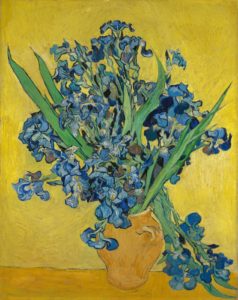In the spring of 1889, following a mental breakdown, Vincent Van Gogh committed himself to an asylum in the French town of Saint-Remy. The doctor there diagnosed his mania and hallucinations as symptoms of epilepsy. Van Gogh, recovering from the notorious ear-cutting incident,, settled in and did what he always did: he painted.

In fact, the restorative year he spent at Saint-Remy was remarkably productive. He painted the asylum’s garden and the view out his bedroom window. He depicted the hallways and courtyards of the asylum – depressing scenes of other patients trudging listlessly about – but his work from nature showed his usual verve. At first, he sketched the insects and birds that visited the garden.
Soon, however, he was making forays into the surrounding landscape. It was here that he painted his swirling cypresses and the ecstatic “Starry Night.”
After a year, he was pronounced well enough to leave. As a coda to his sojourn, he undertook a quartet of flower paintings. It was mid-May. He gathered up flowers from the blooms in the abundant garden. He did two paintings of purple irises and two of pale pink roses. He wrote to his sister that he “worked like a man in a frenzy,” but there is nothing chaotic about their execution. If anything, they are serene.
When Van Gogh boarded a train north, the paintings were left behind to dry. Several weeks later, they were shipped to him in Auvers. The quartet stayed together only briefly. In late July, Van Gogh committed suicide. Two of the paintings hung in his mother’s house until her death in 1906. These were eventually acquired by the Metropolitan Museum.
Now, the museum has borrowed the other two from museums in Washington, D.C and Amsterdam, and, on this, the 125th anniversary of their creation, brought them together once again. Displayed at the center of the museum’s Robert Lehman Wing, they are a handsome set. All are painted on the same size canvas. Two are vertical compositions and two are horizontal, but all four use the same low horizon line – just a small strip of table for the vases to rest on – so that you see the bouquets face on, so to speak.
The paintings were originally composed around strong complementary colors – both yellow-violet and pink-green — and yet these contrasts have been severely diminished. Although this exhibit is celebratory, it’s also an occasion to dwell on the sometimes fugitive nature of beauty in oil paintings.
Van Gogh took a chance on some oil paints that have proved very unstable. These are the light sensitive “red lake pigments” which gradually fade over time. Early postcard copies of the paintings show just how much. The Met’s horizontal irises were arrayed against a pink background that has turned an icy white. The same fate has befallen the two bouquets of Roses de Provence, sometimes called the “hundred-petaled rose.” Once a mix of pinks and ivories, these blossoms have only faint traces of pink, now. A video presentation gives an approximation of how much more vivid several of the paintings originally looked.

The vertical composition of irises from the Van Gogh museum in Amsterdam is the masterpiece of the four and seems to have retained most of its original chromatic punch. The disappearing reds have left the irises somewhat more blue than purple, but the unchanged lemon yellow background makes them look purple, anyway. Van Gogh had a way of animating the inanimate so that the iris’s arabesque petals seem to undulate and reach out into the surrounding air. Poking up like sharp spears are a half-dozen bright green stems and leaves.
Like the Japanese artists he admired, Van Gogh had a special affinity for irises. In his handling, the roses are a softer, more feminine flower. You see none of their thorniness or tough stems. They tumble all over each other as if unable to keep their heads up. Instead of animating the flowers, Van Gogh animated the background with wavy lines that suggest a breeze.
The effect is one of an intoxicating fragrance, which, along with the manic, insistent growth seen in the iris, and the lavish displays of color in both flowers (even if diminished) pretty much sum up the many-faceted spectacle of spring.

